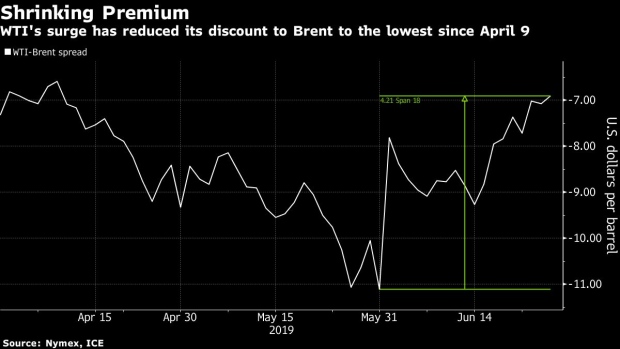Jun 26, 2019
Oil Jumps to Four-Week High on Report of Falling U.S. Stockpiles
, Bloomberg News

(Bloomberg) -- Oil rose to a four-week high after an industry report signaled a bigger-than-forecast drop in U.S. crude stockpiles, adding more impetus to a rally that’s been driven by a tense standoff between Washington and Tehran.
Futures in New York climbed as much as 2.3% after closing down 0.1% Tuesday in the first drop in four days. The American Petroleum Institute reported that inventories fell by 7.55 million barrels last week, according to people familiar with the data. That would be the biggest decline in more than three months, if confirmed by government figures due Wednesday. Gasoline futures jumped in New York after Reuters reported that Philadelphia Energy Solutions is expected to close its refinery, the largest on the U.S. East Coast.
Oil has rallied around 15% since the middle of the month as the increasingly tense situation in the Middle East took over from the U.S.-China trade war as the main price driver. A meeting between the presidents of the two countries at the G-20 summit in Japan over the weekend is generating some optimism that trade talks may be restarted. Meanwhile, the Organization of Petroleum Exporting Countries and allied producers will decide on production levels for the rest of the year at a meeting next week.
A sustained reduction in U.S. inventories moving into the peak summer driving season in the northern hemisphere will support oil prices, said John Driscoll, chief strategist at JTD Energy Services Ltd. in Singapore. The OPEC+ coalition is also expected to rollover its output cuts when it meets next week, he said.
West Texas Intermediate for August delivery rose $1.25, or 2.2%, to $59.08 a barrel on the New York Mercantile Exchange at 7:27 a.m. in London. It climbed to $59.13 earlier, the highest intraday level since May 30. The contract rose 7.7% in the three sessions through Monday.
Brent for August settlement advanced $1.14, or 1.8%, to $66.19 a barrel on London’s ICE Futures Europe Exchange. The global benchmark crude traded at a premium of $7.13 to WTI. The gap was as low as $6.86 earlier, the least since early April.
The API figures compare with the median estimate in a Bloomberg survey for a 2.87 million barrel decline in American stockpiles. Inventories fell by 3.1 million barrels in the week to June 14, according to Energy Administration data. The U.S. summer driving season typically boosts oil demand and has helped narrow the Brent-WTI spread.
Russian President Vladimir Putin will probably discuss oil-output reductions with Saudi Crown Prince Mohammed Bin Salman on the sidelines of the G-20 summit, and the talks could provide a breakthrough on OPEC+ policy before ministers convene in Vienna next week. Russia -- OPEC’s most important ally -- has adopted a wait-and-see approach on the production cuts.
The U.S. is said to be willing to suspend the next round of tariffs on an additional $300 billion of Chinese imports while Beijing and Washington prepare to resume trade negotiations, people familiar with the plan said. However, no detailed trade deal is expected at the G-20 summit, according to a senior Trump administration official. Asian stocks and currencies fell Wednesday, an indication the market isn’t that optimistic about the Trump-Xi meeting.
--With assistance from James Thornhill.
To contact the reporter on this story: Saket Sundria in Singapore at ssundria@bloomberg.net
To contact the editors responsible for this story: Serene Cheong at scheong20@bloomberg.net, Andrew Janes, Ben Sharples
©2019 Bloomberg L.P.


